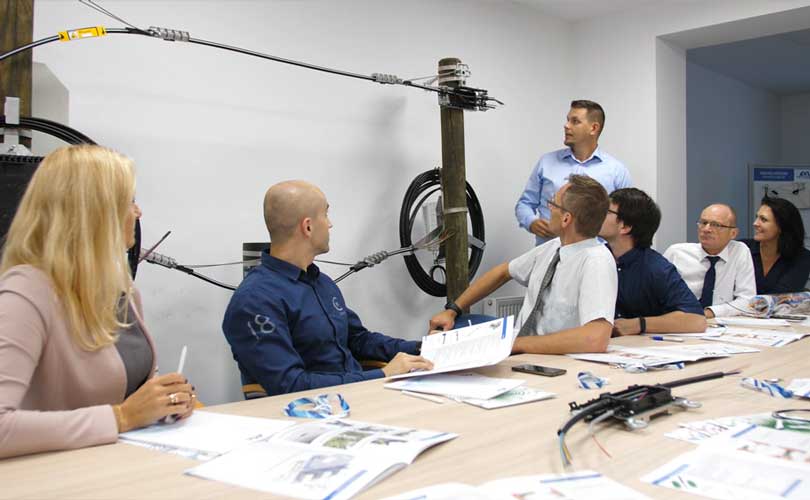STATIONARY
TRAINING
Fibre Optic Training Courses Provided at OPTOMER offices.
Certified training courses carried out at Optomer offices are dedicated for telecom, power industry, CATV engineers and installers as well as for the representatives of public administration who need the basic and/or advanced knowledge on fibre optics.

1. Theory:
- presentation of the selected products, their construction and functionalities
- installation methods, cabling, rules of proper and safe use
- ordering
2. Product groups:
- Cable assemblies
- Passive optical components
- Fibre optic distribution equipment
- Fibre optic outside plant equipment
- Access networks FTTX
- Microducts
- Fibre optic aerial network equipment
- Tools and accessories
- Measuring equipment
3. Practical part:
- assembly, installation, cabling
- presentation of fibre optic connector termination process
Day 1
1. Theory:
- Introduction to fibre optic access networks
- Distribution network construction – principles of planning and products selection
- Rules to follow to install and cable the fibre optic distribution equipment correctly
- Passive optical infrastructure within Multi Dwelling Units (products presentation, products selection and features)
- Passive optical infrastructure within Single Dwelling Housing Developments (products presentation, products selection and features)
- Methods of network failures removal
- Summary, questions, open discussion. Examples of installations carried out by OPTOMER
Day 2
- Practical part – workshops
- Network planning task
- Exam
1. Passive optical components:
- FBT couplers and PLC splitters
- WDM and CWDM multiplexers
- Optical circulators
- Housings for passive optical components
2. Practical part – workshops
Day 1
- Passive optical network components and their influence on measurements
- Types of optical fibres
- Practical aspects of the used fibre standard, fibre manufacturer
- Fibre splicing – practical aspects
- Measurements – theory
- Unique measurement phenomena and their reasons
Day 2
1. Practical training:
- splicing
- transmissive method of insertion loss measurements
- interferometric measurements
2. Discussion on measurement results
3. Exam
Day 1
Introduction:
- Blowing theory
- Components of microduct network infrastructure
- Microduct overview:
- Loose protected microducts
- Tight protected microducts
- Closureless system
- Network planning
- Network failures
Day 2
Practical training:
- Practical cable blowing presentation
- Exam
Day 1
Introduction:
- Aerial networks theory
- Advantages and disadvantages
- Components of aerial network architecture:
- cables
- brackets
- suspensions
- aerial cable vibration dampers
- pole mountable closures and distribution boxes
- Installation of standard outdoor cables
- Figure-8 cables installation
- ADSS cables installation
- Installation of aerial networks:
- Network failures
- Products sellection
- Practical presentation
- Exam
Day 1
- Passive optical network components and their influence on measurements
- Types of optical fibres
- Practical aspects of the used fibre standard, fibre manufacturer
- Fibre splicing – practical aspects
- Measurements – theory
- Unique measurement phenomena and their reasons
Day 2
1. Practical training:
- splicing
- transmissive method of insertion loss measurements
- interferometric measurements
2. Discussion on measurement results
3. Exam
1. Theory:
- presentation of the selected products, their construction and functionalities
- installation methods, cabling, rules of proper and safe use
- ordering
2. Product groups:
- Cable assemblies
- Passive optical components
- Fibre optic distribution equipment
- Fibre optic outside plant equipment
- Access networks FTTX
- Microducts
- Fibre optic aerial network equipment
- Tools and accessories
- Measuring equipment
3. Practical part:
- assembly, installation, cabling
- presentation of fibre optic connector termination process
Day 1
1. Theory:
- Introduction to fibre optic access networks
- Distribution network construction – principles of planning and products selection
- Rules to follow to install and cable the fibre optic distribution equipment correctly
- Passive optical infrastructure within Multi Dwelling Units (products presentation, products selection and features)
- Passive optical infrastructure within Single Dwelling Housing Developments (products presentation, products selection and features)
- Methods of network failures removal
- Summary, questions, open discussion. Examples of installations carried out by OPTOMER
Day 2
- Practical part – workshops
- Network planning task
- Exam
1. Passive optical components:
- FBT couplers and PLC splitters
- WDM and CWDM multiplexers
- Optical circulators
- Housings for passive optical components
2. Practical part – workshops
Day 1
- Passive optical network components and their influence on measurements
- Types of optical fibres
- Practical aspects of the used fibre standard, fibre manufacturer
- Fibre splicing – practical aspects
- Measurements – theory
- Unique measurement phenomena and their reasons
Day 2
1. Practical training:
- splicing
- transmissive method of insertion loss measurements
- interferometric measurements
2. Discussion on measurement results
3. Exam
Day 1
Introduction:
- Blowing theory
- Components of microduct network infrastructure
- Microduct overview:
- Loose protected microducts
- Tight protected microducts
- Closureless system
- Network planning
- Network failures
Day 2
Practical training:
- Practical cable blowing presentation
- Exam
Day 1
Introduction:
- Aerial networks theory
- Advantages and disadvantages
- Components of aerial network architecture:
- cables
- brackets
- suspensions
- aerial cable vibration dampers
- pole mountable closures and distribution boxes
- Installation of standard outdoor cables
- Figure-8 cables installation
- ADSS cables installation
- Installation of aerial networks:
- Network failures
- Products sellection
- Practical presentation
- Exam
The training courses are supported by fibre optic experts,
well qualified designers and skilled installers.
If you are interested in the selected training course please contact us via the application form.
THEY TRUSTED US




















